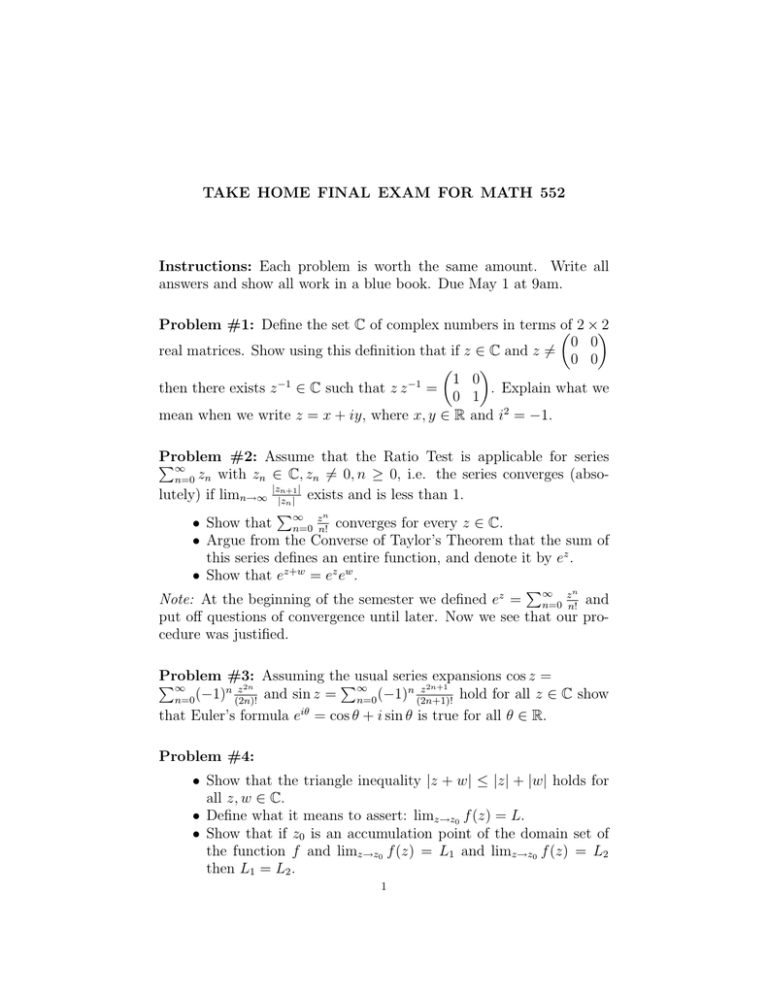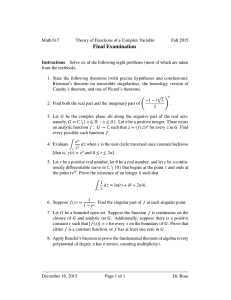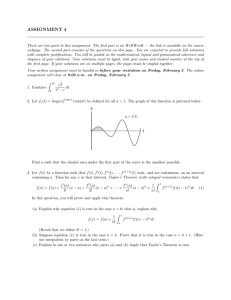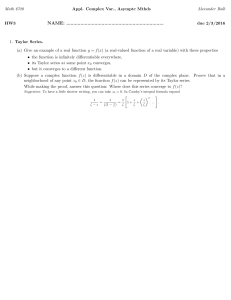TAKE HOME FINAL EXAM FOR MATH 552 Instructions: Each
advertisement

TAKE HOME FINAL EXAM FOR MATH 552
Instructions: Each problem is worth the same amount. Write all
answers and show all work in a blue book. Due May 1 at 9am.
Problem #1: Define the set C of complex numbers in terms µ
of 2 ׶2
0 0
real matrices. Show using this definition that if z ∈ C and z 6=
0 0
¶
µ
1 0
. Explain what we
then there exists z −1 ∈ C such that z z −1 =
0 1
mean when we write z = x + iy, where x, y ∈ R and i2 = −1.
Problem
#2: Assume that the Ratio Test is applicable for series
P∞
n=0 zn with zn ∈ C, zn 6= 0, n ≥ 0, i.e. the series converges (abso|
lutely) if limn→∞ |z|zn+1
exists and is less than 1.
n|
P∞ zn
• Show that n=0 n! converges for every z ∈ C.
• Argue from the Converse of Taylor’s Theorem that the sum of
this series defines an entire function, and denote it by ez .
• Show that ez+w = ez ew .
P
zn
Note: At the beginning of the semester we defined ez = ∞
n=0 n! and
put off questions of convergence until later. Now we see that our procedure was justified.
Problem #3: Assuming the
series expansions cos z =
P
Pusual
∞
∞
n z 2n
n z 2n+1
n=0 (−1) (2n)! and sin z =
n=0 (−1) (2n+1)! hold for all z ∈ C show
that Euler’s formula eiθ = cos θ + i sin θ is true for all θ ∈ R.
Problem #4:
• Show that the triangle inequality |z + w| ≤ |z| + |w| holds for
all z, w ∈ C.
• Define what it means to assert: limz→z0 f (z) = L.
• Show that if z0 is an accumulation point of the domain set of
the function f and limz→z0 f (z) = L1 and limz→z0 f (z) = L2
then L1 = L2 .
1
2
Problem #5: Assume U ⊂ C is open and z0 = x0 + iy0 ∈ U and
f : U → C is a function.
• Define (in terms of limits) what it means to assert f is Cdifferentiable at z0 .
• If u(x, y) = ℜf (x + iy) and v(x, y) = ℑf (x + iy) whenever
x, y ∈ R, x + iy ∈ U , then show that the Cauchy-Riemann
equations hold at (x0 , y0 ) whenever f is C-differentiable at z0 .
• Suppose the Cauchy-Riemann equations hold at (x0 , y0 ). Give
additional conditions on u and v which are sufficient to guarantee that f is C-differentiable at z0 .
Problem #6:
• For nonzero z ∈ C define Ln(z).
• Show that Ln(z) is analytic on the set C \ (−∞, 0].
d
• Show that dz
Ln(z) = z1 for z ∈ C \ (−∞, 0].
Problem #7: Suppose Z : [a, b] → C is a parameterization of a smooth
arc C = range(Z), and f : C → C is a function so that f (Z(t)) is continuous for t ∈ [a, b].
R
• Define the contour integral C f (z) dz.
• Give a parameterization
forR the reversed contour −C.
R
• Show that −C f (z) dz = − C f (z) dz.
Problem #8:
• Define what it means to assert that D ⊂ C is a domain.
• Suppose D is a domain and f is analytic on D and real-valued
on D. Show that f (z) is constant.
Problem #9: Suppose D is a domain and f (z) is continuous on D.
• Does an antiderivative F (z) necessarily exist for f (z)? Hint:
consider f R(z) = z1 for z ∈ D = C \ {0}.
• Compute C z n dz, for each n ∈ Z, where C is the unit circle
oriented in the counterclockwise direction.
Note: Antiderivatives always exist for continuous real-valued functions
defined on intervals (a, b) ⊂ R. This is a consequence of the Fundamental Theorem of Calculus.
Problem #10: Prove the Cauchy-Goursat Theorem for a rectangle
(without assuming f ′ (z) is continuous). You should use but do not
need to prove the following lemma.
3
Lemma. Suppose R = [a, b] × [c, d] and f (z) is analytic at each point
of R. For every ǫ > 0 there exists an integer n ≥ 1, determining a
subdivision of R into n2 subrectangles R1 , . . . , Rn2 each of which are of
dimensions (b−a)
× (d−c)
, and there exist points zj ∈ Rj , 1 ≤ j ≤ n2
n
n
such that for every 1 ≤ j ≤ n2 and every point z 6= zj on the boundary
of Rj we have that
¯
¯
¯ f (z) − f (zj )
¯
¯
¯ < ǫ.
−
f
(z
)
j
¯ z − zj
¯
Problem #11:
• State the Cauchy Integral Formula for f (n) (z0 ) with all its needed
hypotheses.
• Assuming this result is true show that the case n = 2 allows us
to conclude that derivatives of analytic functions are themselves
analytic.
• If f is an analytic function and f = u + iv as in problem #5
then show that u and v have continuous partial derivatives of
all orders.
Note: The function f (x) = x|x| is R-differentiable at all x ∈ R and
f ′ (x) = |x|. However f ′ is not R-differentiable at x = 0.
Problem #12: State and prove Morera’s Theorem using the second
part of problem #11.
Problem #13: State and prove Taylor’s Theorem.
Problem #14: State a converse to Taylor’s Theorem.
Problem #15: State Laurent’s Theorem.
Problem #16: Use the Cauchy Residue Theorem to show that
π
.
= 2√
2
R∞
0
dx
x4 +1





